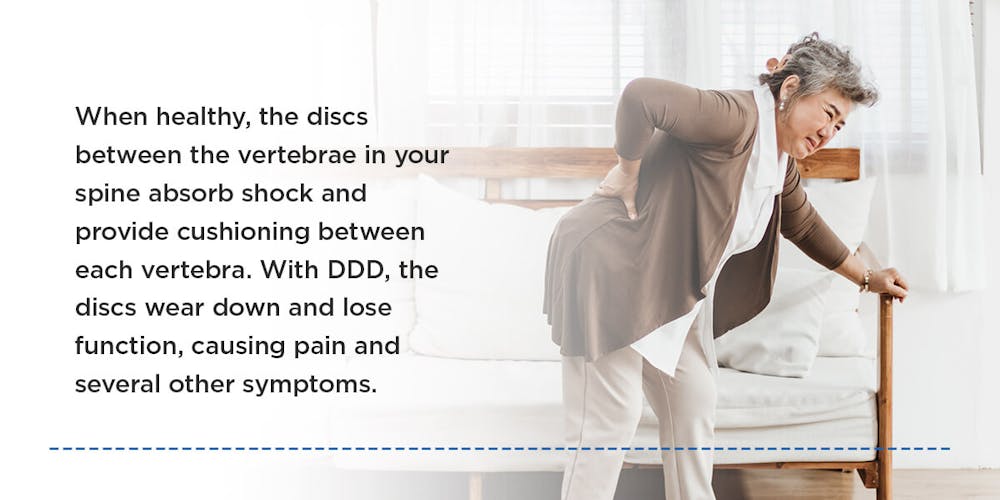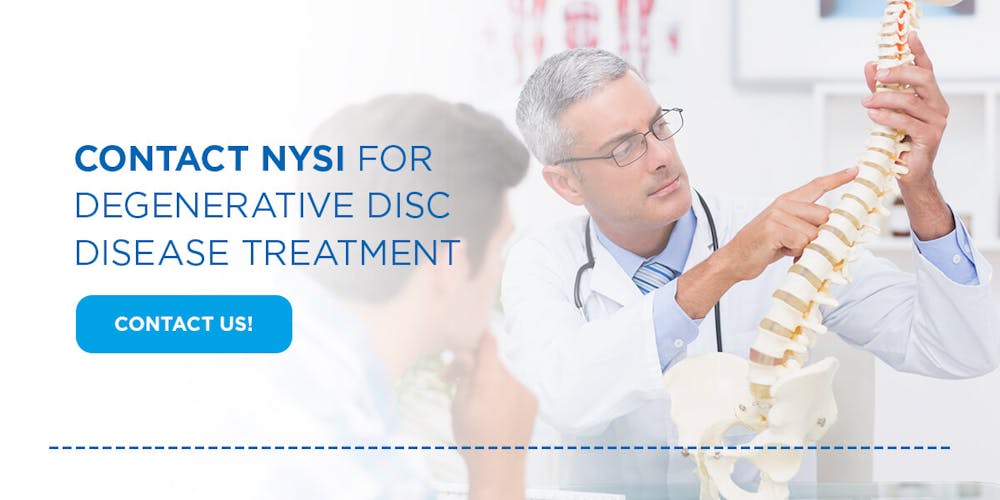Degenerative disc disease (DDD) is a common spinal condition affecting many adults. A recent study shows that one-third of individuals between 40-59 years old experience DDD. With that prevalence, it’s crucial to consider the signs and symptoms of DDD so you can seek early treatment if you’re experiencing this condition. Continue reading to learn more about DDD, its symptoms and treatment options.

What Is Degenerative Disc Disease?
DDD is a spinal condition that occurs naturally as a person ages. That said, many people are lucky enough to avoid DDD as they age. Although it is called a disease, it is unlike most other diseases. Rather, DDD is more similar to conditions like arthritis.
When healthy, the discs between the vertebrae in your spine absorb shock and provide cushioning between each vertebra. With DDD, the discs wear down and lose function, causing pain and several other symptoms. There’s less cushioning for the vertebrae so they absorb less shock. Since discs don’t receive blood supply, they can’t regenerate once they start wearing down.
Although DDD occurs naturally with age, other reasons explain why it happens. The main causes of DDD are:
- Drying out: Your spinal discs consist mostly of water. They gradually dry out as you age, which causes them to thin and flatten out. As this happens, they provide less cushioning and absorb less shock. Drying out is the most natural cause of DDD.
- Cracking: Your spine supports every movement your body makes. Thus, the spinal cord is a wonder of durability. Still, our movements take a toll. While we may be unable to account for every movement we’ve made in our lifetime, our spines keep the score. Often, that score involves tiny cracks and tears in a disc’s outer wall. When these cracks and tears occur, our discs degenerate faster, become more prone to herniation and cause increased nerve discomfort.
- Trauma or injury: In some cases, DDD occurs due to external causes like trauma or sudden injury to the spine. In these cases, trauma accelerates the disc damage, so a person experiences DDD sooner than expected.
With that in mind, aging is the primary DDD risk factor. Other risk factors exist, though, including:
- Excess weight on spinal joints
- Family history of DDD
- Increased wear and tear due to sports or physically demanding jobs that involve heavy lifting
- Previous spinal injuries
- Smoking cigarettes or other tobacco products
DDD most commonly occurs in the lumbar or cervical spine. It rarely affects the thoracic spine. If you experience DDD symptoms in your lower back, it indicates lumbar DDD. Conversely, DDD symptoms in your neck suggest cervical DDD.
Early Warning Signs and Common Symptoms
The warning signs and symptoms of DDD are different than what you might expect. For example, DDD pain is often more severe for younger individuals than for patients past the age of 60. Further, severe DDD pain doesn’t necessarily indicate severe disc damage. Mild damage often produces severe pain, while severe damage sometimes produces no pain.
In that light, here are some early warning signs and common degenerative disc disease symptoms:
- Inability to sit or stand for long periods: An unexpected aspect of DDD pain is that it increases when you’re stationary and decreases when you move or change positions. When pain hits, it’s natural to want to rest and limit activity. That said, DDD symptom mitigation requires regular movement. Walking keeps your spine and discs flexible. Increased pain when sitting or standing indicates lumbar DDD. Comparatively, cervical DDD may cause increased pain when looking at a book or cellphone.
- Numbness in the fingers, arms or legs: This symptom is a serious DDD warning sign. Numbness in extremities and limbs indicates the degenerating discs are putting pressure on the surrounding nerves.
- Sharp, intermittent pain: Although DDD pain is usually low-grade and continuous, it’s also characterized by occasional flare-ups of sharp, intense pain. These flare-ups stick around for a while and can cause debilitating pain. In some cases, this pain may radiate and feel hot. Cervical DDD involves radiating pain in the shoulder, arm or hand, known as cervical radiculopathy. Lumbar DDD involves radiating pain in the hips, buttocks or down the back of the leg, known as lumbar radiculopathy.
- Spinal instability: If you feel like your back or neck is “giving out,” you’re probably dealing with spinal instability. When these sensations occur, it may feel like your spine can’t provide basic support. The spine may also lock and hinder your mobility.
- Muscle tension and spasms: Spinal instability also causes muscle tension and spasms. Although staying mobile decreases DDD pain, specific movements may increase pain due to muscle tension. Such movements may include bending, twisting or lifting a heavy object. Likewise, certain stationary positions may decrease DDD pain, like using a pillow that supports your neck’s natural curvature can limit DDD pain.
Diagnosis and Treatment
Diagnosis for DDD involves at least two stages, sometimes three.
1. Initial Consultation
During this stage, you and your doctor will review your medical history and discuss:
- Your symptoms, such as when they began, their frequency, location, severity and impact on your mobility.
- Your dietary and exercise habits, sleeping patterns and general activity level.
- The activities or postures that ease or worsen your symptoms.
2. Physical Examination
After gathering this information, your doctor will conduct a physical examination. The physical examination stage involves palpation and a range of motion or reflex test. “Palpation” is the medical term for using fingers and hands to examine a problem area.
As they palpate the spine, they check for abnormalities, tender spots and swelling. The reflex or range of motion test will see how much movement your spine allows. During these tests, your doctor will likely ask you to bend your spine forward, backward and to the side.
3. Magnetic Resonance Imaging (MRI)
If these first two stages provide inconclusive information to diagnose or rule out DDD, your doctor may order magnetic resonance imaging (MRI). The MRI can show if other issues are contributing to the symptoms, such as:
- Disc dehydration, fissures or tears
- Fractured vertebrae
- Herniated disc
If your doctor diagnoses you with DDD, you have several treatment options. These options vary with each patient, with surgery being a last resort. In almost all DDD cases, doctors recommend physical therapy. Physical therapy restores function and mobility, decreases pain and prevents disability through modalities, such as:
- Active and passive stretching
- Exercise programs like yoga
- Hot and cold therapy
- Manual therapy, or soft tissue mobilization
To help with pain, your doctor may also prescribe non-steroidal anti-inflammatory drugs (NSAIDs). If surgery is necessary, the main options are fusion surgery or disc replacement surgery.
Fusion surgery involves joining two vertebras. In contrast, disc replacement surgery involves replacing the damaged disc with an artificial one. Early treatment of DDD leads to the best outcomes and increases your chance of avoiding surgery.
Contact NYSI for Degenerative Disc Disease Treatment
If any degenerative disc disease symptoms resonate with you, put your mind at ease by scheduling a consultation with one of our spine specialists at New York Spine Institute. Our team of medical professionals will help determine the cause of your symptoms and provide specialized treatment solutions.

